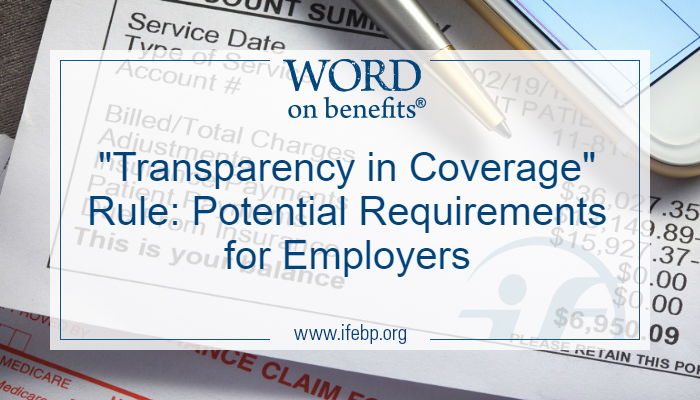
On June 24, 2019, President Trump issued an executive order directing various federal agencies to develop new rules or regulations on improving price and quality transparency. As a result, on November 15, 2019, the Departments of Labor, Health and Human Services, and the Treasury (the Departments) released a proposed rule, “Transparency in Coverage”, which affects group health plans and health insurers.

What is the purpose of the proposed “Transparency in Coverage” rule?
The goal of the rule is to create greater transparency in the health care industry by requiring group health plans and health insurers to provide consumers with access to information similar to what is included in an explanation of benefits (EOB) form. Consumers could get the information before obtaining treatment rather than after, allowing them to more easily comparison shop for health care services and prescription drugs.
What are the requirements for employers?
Non-grandfathered group health plans and health insurers in the individual and group markets would be required to:
- Share cost information at no cost to the participant and personalize out-of-pocket cost data for all covered health care items and services through an internet-based, self-service tool with real-time access to information. If requested, the information also must be provided in paper form.
- Communicate the in-network negotiated amount that the individual would be expected to pay network providers for a covered item or service and amounts allowed for out-of-network providers
- Disclose cost-sharing information and negotiated rates for in-network providers and allowed amounts for out-of-network providers
- Include provisions for insurers that encourage consumers to shop for services from lower-cost, high-value providers and then share any resulting savings as part of their medical loss ratio (MLR) calculations.
The proposed rule does not address potential liability of the plan or issuer if an individual is billed for a significantly higher amount than was estimated prior to service. This could be addressed in any future revisions.
What about self-insured plans?
Self-insured plans rely on their third-party administrators (TPAs) or administrative services only (AS0) providers to handle day-to-day administrative responsibilities for their plans. The proposed rule would allow for continued delegation and the transferring of some liability to these partners for tasks such as:
- Providing cost-sharing data that would estimate the participant’s responsibility for deductibles, coinsurance or copays
- Providing accumulated amounts already paid such as deductibles or treatment limits for services, such as costs of physical therapy visits
- Providing rate disclosures for in-network services, negotiated rates or out-of-network allowed amounts. The plan would still be liable for rate disclosure non-compliance.
- Providing a notice that an item or service requires prior authorization or additional review.
The proposed rule would include a non-compliance safe harbor, so plans acting in good faith would not be liable for errors or omissions by a third party.
The proposed rule would not apply to excepted benefits such as separate dental or vision plans, short-term limited duration insurance, health reimbursement arrangements or other account-based plans.
What is the next step?
Currently, the proposed rule is in a comment period through January 29, 2020 (extended from original due date of January 14). Comments are requested on the following topics:
- Whether group health plans and health insurance issuers that would be required to disclose cost-sharing information through an internet-based self-service tools should be required to use a standards-based application programming interface (API). APIs are the messenger tools that work behind the scenes to ensure that software programs can talk to one another.
- How price transparency proposals could incorporate information on health care quality.
After reviewing the comments, the Departments will determine if the proposed rule requires revisions and then decide on how to proceed. Until a final rule is released, the potential effective date is unknown.

Additional “Transparency in Coverage” Resources
- The Departments have released three initial documents for review:
- Price Transparency: Federal Government Issues Final Rule for Hospitals and Proposed Rule for Group Health Plans and Health Insurers – Foley & Larder, LLP
- Transparency in coverage rule – Potential implications for self-insured health plans – Eversheds Sutherlund, LLP
- Proposed Rule Would Require Transparency of Cost-Sharing and Pricing Information – Segal
![]()
Anne Newhouse, CEBS
Information/Research Specialist at the International Foundation of Employee Benefit Plans
The latest from Word on Benefits:
- Neurodivergence in the Workplace: Steps for Employers
- What Health Plan Sponsors Should Know About the Emerging Mental Health Needs of Youth
- Educating DC Plan Participants for the Long Hike to Retirement
- Reducing Loneliness: 4 Action Steps for Employers
- Building and Designing for DEI: Creating Employee Benefits That Work for All






Janice Scherwitz
Many carriers already have this type of tool a ‘know before you go” type of application. Patients would be better-served by price lists at provider offices and places of service. Currently we purchase our healthcare blindly and while it is good to have an idea of what the carrier will cover, it would be equally helpful to know what we (or the carrier) are being charged.